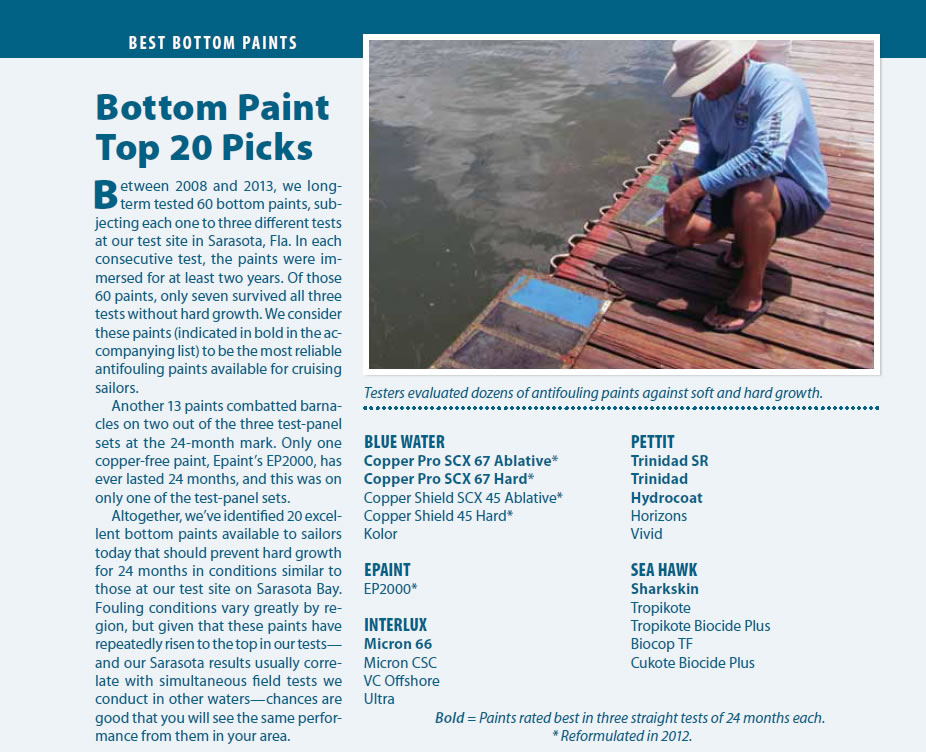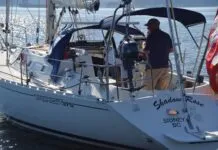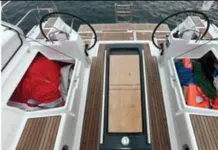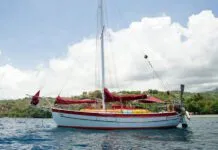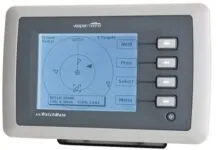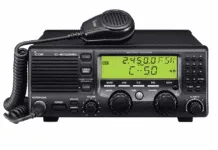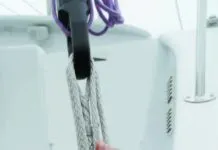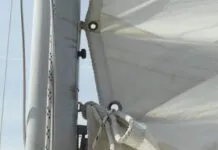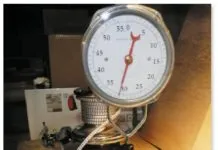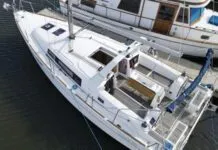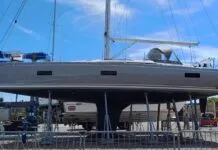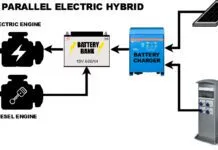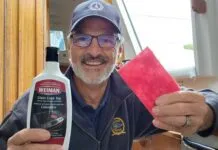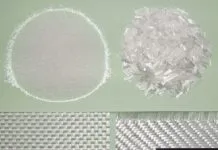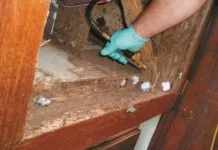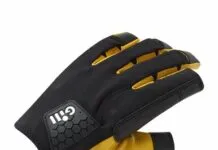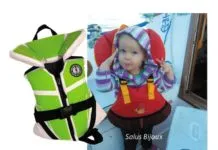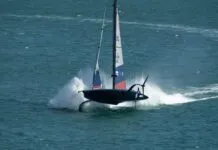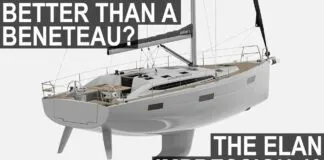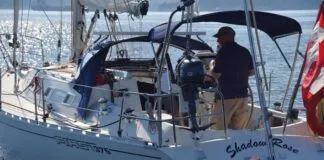Photos by Ralph Naranjo and Drew Frye
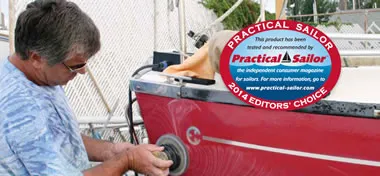
During the 12-month period from September 2013 through August 2014, Practical Sailor evaluated dozens of boating products, ranging from autopilots and water heaters to hose clamps and sanitation hose. The following products not only earned Practical Sailors Best Choice rating, marking each as the best in its category, but they also earned a spot on our list of 2014 Editors Choice products. To be named to the Editors Choice roster, a product must excel in Practical Sailors tests, and clearly stand out above others in its field.
Because these products are often the more expensive options in their class, in some gear categories, small boat owners and coastal sailors will be satisfied with less-expensive, mid-range gear that might lack the bells and whistles that offshore cruisers demand. For this reason, we have two other product designations in our test ratings-Budget Buy (the least expensive product that meets our tough criteria) and Recommended (a product that meets our criteria and fills a particular need or niche). If you search our online archives for the original test reports referenced in this article, you can see which products earned Recommended and Budget Buy ratings, but did not make the Editors Choice list.
and courtesy of makers
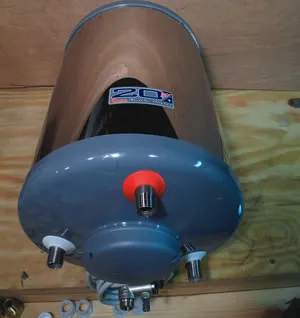
Quick Nautique
In the December 2013 issue, we dove into the world of water heaters, evaluating moderate-capacity units. Most of these were dual-mode units, equipped with both an AC electrical heating element for dockside use, and a heat-
exchanger that transfer heat from an engines coolant to the boats water supply. We tested four heaters, including the Kuuma 11842, the Quick Nautique BX2012, Raritans 1706, and the 30-liter Compact from Sigmar Marine. All but the 11-gallon Kuuma had 5- to 6-gallon tanks. The test field included stainless-steel, aluminum, and mild-steel boilers.
Testers looked at heat-exchanger efficiency, temperature, and construction quality. We checked electrical circuitry, the construction of plumbing attachments, and the welds around fittings.
Testers liked that the Quick unit could be mounted horizontally or vertically and that users can adjust the angle of the mounting base. The Quicks cylindrical shape also makes it easier to mount the water heater low in the bilge, which helps keep the boats center of gravity low. The small 20-liter unit we tested is available with different heating elements (500, 600, and 1,200 watts), which significantly affect the time it takes to heat up cold water. Our test heater was equipped with the highly efficient 1,200-watt element, which quickly produced very hot water, reminding testers that a mixer valve to introduce cold water as needed is a valuable ally in these systems.
Unlike other heaters, the Quick Nautique showed no sign of ferrous metal parts. The boiler is made of highly corrosion-resistant 316L stainless steel, the outer shell, where corrosion conditions are not so hostile, is a polished 304-grade stainless steel. While the overall construction quality of the Quick Nautique BX2012 and Sigmar Marines BC30 UC08 were both very good, in the end, the Quick Nautiques blend of quality materials and workmanship earned it our top pick and a place on the 2014 Editors Choice list.
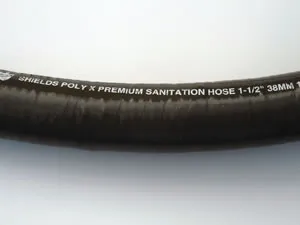
Shields Poly-X
We reported on our long and harrowing quest to reduce head odor-a 30-month test of sanitation hoses-in the December 2013 issue. The test, which involved backyard bench testing with mini holding tanks and ocean testing aboard a PDQ 32 catamaran, featured a cross-section of popular marine hoses: Trident Marines 101/102 EPDM hose; SeaLands OdorSafe Plus, a PVC and acrylonitrile butadiene rubber hose; Raritan Engineerings butyl rubber Sani/Flex Odor Shield; and Shields Marines Poly-X polyurethane sanitation hose. We added schedule 40 PVC sanitation pipe and clear vinyl hose to the mix for comparison.
The hoses were tested for flexibility, ease of fitting, ease of cleaning, and odor retention. We used sniff tests (wrapping hoses in aluminum for a week and then smelling the results) and a hydrogen sulfide monitor for the final and most important test: whether the hose allowed odor to escape. To maximize hose permeation, the bottom of each tank was fitted with a sanitation hose so that the hoses were continuously filled with sewage.
There were major differences among the hoses when it came to cleaning. Some required heavy scrubbing or wouldnt clean at all, but cleaning the Poly-X was a breeze; it resisted mildew to an amazing extent and was cleaned with a quick wipe of a cloth without any need for soap. When the homemade holding-tank systems were put to rest, testers found that removing the Shields Poly-X required a bit of vigor, but the hose came off cleanly within a minute or two. Only the vinyl hose was stiffer than the Poly-X, but Poly-X was not difficult to push onto fittings.
After 30 months, the Shields Marine Poly-X hose was flawless, showing no permeation, and it comes with a lifetime warranty against permeation. At $19.62 per foot, it isn’t cheap, but when it came to controlling odor, this was money well spent.
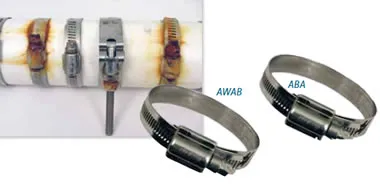
AWAB & ABA
In a two-part test, completed in the summer of 2014 (see PS August 2014 online), Practical Sailor evaluated stainless-steel hose clamps from 11 manufacturers, including Shields, ABA, Murray, AWAB, Breeze, American Valve, Ideal/Tridon, Trident, Koehler, and Norton. We tested sizes 28 (for hose sizes 15/16 to 2 inches) and 32 (for hoses 1 to 2 inches).
The tests compared compression, torque failure, and long-term corrosion resistance. For compression testing, we tightened each clamp to 50 inch-pounds and measured clamp compression at that torque. The manufacturers we spoke with generally agreed that a torque of 45 to 60 inch-pounds is sufficient for critical hose compression (through hulls, exhaust hose), and that 15 to 20 inch-pounds is normal for non-critical hoses (potable water supply lines). To measure the clamps failure points, we tightened them on a PVC pipe until the hose clamp broke or began to slip.
Based on our experience, corrosion is the chief cause of hose-clamp failure, so we were most interested in the clamps resistance to corrosion. All test clamps were attached to a 2-inch PVC pipe and immersed in a saltwater bath for 18 months. Two winners emerged from the corrosion bath: the clamps from AWAB and ABA. These worm-gear clamps operated smoothly, provided even compression, and showed almost no sign of corrosion. Both have 0.485-inch-wide bands, are made of 316 stainless, and use stamped serrations rather than holes for the screw threads. Compared to their counterparts, they performed well enough to earn a spot on our Editors Choice roster.

Imtra Gibraltar
In mid-spring 2014, we wrapped up an extensive test of interior LED cabin lights (see PS May 2014 and June 2014 online). The test delved into the latest developments in LED illumination, a field in which the technology is advancing quickly and product prices vary widely. Our tests looked closely at the design and construction of the marine light fixtures and how they would be installed aboard a sailboat. We tested illumination, color temperature, and beam width.
Some important observations that testers noted: The best cabin lighting combines LED light sources with good constant-voltage controllers, properly angled reflectors, and optically efficient diffusion lenses. Also, radio frequency interference wasnt just caused by the proximity of a radio to a poorly suppressed LED driver, but in some cases, we noted that the interference was actually impressed into the DC wiring and propagated throughout the boat.
In the dome-light category, Imtras Gibraltar Bi-color with a three-way switch and a five-year warranty offered a lesson in how cabin lights should be made. The frosted-glass diffuser wont craze with time. The conical reflector shapes the light into a well-controlled beam, and the wiring connections and circuitry show true attention to detail. The illumination is even, the RF hiss is low, and the switch simplicity makes sense. This is a fixture that can be easily repaired or upgraded, and such attributes are of value to long-term cruising sailors.
The lights only downside is the high cost, more than $200 retail, nearly eight times the price of the entry-level, plastic LEDs in this category.
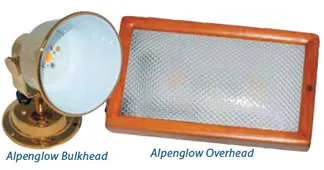
Alpenglow Lights
Alpenglow took our top pick in both the overhead and bulkhead LED cabin light categories. The companys classic 10-inch by 6-inch by 2-inch overhead light features a dual red/white and high/low power lamps. The bright, wide-angle illumination is a byproduct of a unique custom-molded diffusion lens, creating a very efficient light source. The high-power setting sucked up 0.6 of an amp, slightly more than some others in this group, but the illumination delivered was worth it.
Alpenglows new 7-inch by 7-inch, bulkhead-mounted, overhead light, which is slightly dimmer and draws less current than its big brother, also rose to the top with its well-engineered housing and efficient, bright light. Testers liked the reliable simplicity of the high-quality rocker switches and the warm glow of our chosen LEDs. We were able to put the antenna of our RFI-sensing VHF radio right on this light without even raising a whisper.
Both of these Alpenglow LED cabin lights grabbed the honor of becoming Editors Choice products.
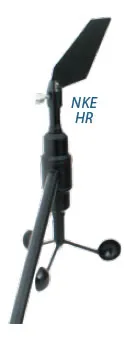
NKE HR
For better or for worse, the modern cruising sailor is becoming more like an airplane pilot. Safely ensconced out of the wind, the helmsman relies on wind sensors to do everything from gauge wind speed to direct the autopilot. So which devices can you count on to carry out these tasks? We launched a multi-part series of tests on wind instruments to find out.
In our first installment (see PS March 2014 online), testers looked at seven traditional wind-sensing units that use paddlewheels and rotating vanes to collect wind data. Our test field included the NKE HR, Nexus nWind (now known as the Garmin gWind), Garmin GWS 10, Raymarine Tacktick wireless, Raymarine i60 Wind System, B&G Triton 508, and the Sailtimer.
Testing was done indoors using a homemade wind tunnel. Speed was measured with two wind meters at a fixed location, compared to the sensors, in normal conditions, and then for the affect of heeling.
Made of anodized and machined aluminum on a stainless-steel bracket, the NKE HR, which also sends temperature data, is NKEs top racing unit and was the most rigid sensor when mounted. Both the lightweight carbon-fiber vane and the cup anemometer moved smoothly. The NKE has its own display, which is designed to interface with NMEA 2000 systems but can be modified for standard NMEA 0183 output.
Assembly is straightforward with the NKE HR. The anemometer base is 5 inches above the mount base when installed, although it has an optional mount to place the sensor in cleaner air. The NKE anemometer and vane were extremely sensitive in light wind. While the average cruising sailor will do fine with one of the other less-expensive units in our test, the NKE was clearly the specialist in this field, earning it a spot on the Editors Choice roster.
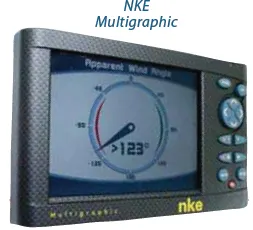
NKE Multigraphic
Its dusk on an overcast, gusty day, and raw data is pouring into your wind display from the masthead, GPS, and knot log. Can you rely on your wind instrument displays to give you the information you need quickly and clearly? In our second installment on wind sensors (see PS March 2014 online), we tested a few displays, including the Raymarine i60, the B&G Triton T-41, Garmin GMI 20, and NKE Multigraphic, as well as two wireless units, the Raymarine MN100-2 and Nexus nxWind Plus.
We tested all units with their respective wind transducers, and where possible, we interfaced the units with GPS data from a multifunction display (either a Garmin 741xs or a Raymarine e7D). In a few cases, wind data was also output to one of the two multifunction displays (MFDs) to evaluate the appearance on their wind data pages.
On the NKE Multigraphic, our Best Choice display, we tested interface user-friendliness by counting the number of actions it takes to access key data. The feature-rich display allows precise calibration of apparent-wind angle and boat speed; displays for Automatic Identification System data; alarms for wind speed, wind angle (both true and apparent), and system-related elements; and the ability store information for 48 hours.
Each display was rated according to ease of installation, display quality, and features. The largest display we tested, the NKE has a color-transflective LCD with embedded LED backlighting. It is clearly visible at difficult angles and through polarized glasses, and it automatically adjusts to the level of sunlight. The function buttons were also glove-friendly.
As with our anemometer tests, we found other, more affordable displays for the cruising sailor on a budget, but for those for whom price is not a factor, the hyper-featurized NKE Multigraphic will tell you almost everything you need to know about the wind. Its a 2014 Editors Choice pick.
Photos by Ralph Naranjo and Drew Frye

0)]
DMK Multiplexer
Linking laptops to nav gear has never been easier with new wireless multiplexers that allow multiple electronic devices to feed data to your devices. We evaluated four multiplexers, three of which had WiFi capabilities. The major differences were in capabilities, connections, and installation. In general, the multiplexers we tested worked as advertised.
DMK Yacht Instruments 11A, the only one that offered NMEA 2K and SeaTalk support in our test, was our Best Choice and earned an Editors Choice spot. The manufacturer is a relatively new company from Seattle, and so far, this is the only product it makes.
We installed the test units on a Gulfstar 36 and evaluated them during a three-month cruise. Testers used both an iPad and a MacBook Air laptop to receive the multiplexers Wi-Fi information from various on-board electronic devices from a transponder to an old Garmin 76 GPS. We made subjective judgments about the ease of installation and operation and the output from the units. In future tests, we will look at interface with various multi-function displays, autopilots, and other instruments.
Customers can opt to get DMKs $499 sealed polycarbonate box with a built-in 14-channel GPS or save $100 and buy it without the GPS. Through the clear polycarbonate cover, you can see the six LEDs that indicate status and connections.
The unit can be powered by its SeaTalk or NMEA 2K connection, or it can be wired directly to the boats 12-volt system. The boxs Wi-Fi signal can be received by Wi-Fi-ready devices and can be adjusted to send to three different receivers. Setup is straightforward (for a multiplexer)-it has a rats nest of wires, but connections are pretty plain. The user manual, website, and free iPad app are great, as is their tech support.
Photos by Ralph Naranjo and Drew Frye

1)]
Seldn GX15
Top-down furlers, furling systems designed to handle asymmetrical spinnakers, have proven to be a legitimate means of taking the drama out of spinnaker setting and dousing. In the February 2014 issue, we wrapped up a two-part test of these furlers; it included the Colligo CN3S, Karver KSF2, Profurl Spinex 2.5, Ronstan Series 120, and the Seldn GX15. Bearing systems, pins, clips, and how the endless reefing line is reeved differed from unit to unit. All featured half-inch-diameter anti-torsion lines, but the line details and terminal fittings varied.
We tested the furlers ease of installation, use, and construction quality. We also carried out on-the-water testing, where testers found that although the furlers with larger-diameter furling sheaves were slower, this design made it easier to haul on the furling line.
In our workshop, the test jig imposed tension on the torque rope, and a secondary line added side-load to find out how much tension had to be placed on the furling line in order to wind up each sail. Testers also disassembled mechanically fastened components and used magnets to evaluate the alloy type and quality of furler hardware.
Seldns GX15 handled furling tasks quite nicely, but from a cruisers perspective, what set it apart was its robust construction. At the heart of the drive system is a stainless-steel axle shaft that snap shackles to the tack. At the opposite end of this 2-inch shaft is a unique compression fitting that locks in the torque rope. The 5.9-inch-diameter sheave spins on a stainless-steel thrust bearing. We found no magnetic signature in the castings, but did find that the swivel axle was magnetic, suggesting that sailors should monitor this component for corrosion.
The split sheave in the endless-line drum is held together with a multi-slotted interface and seven small stainless screws. This design allows users to replace the aluminum teeth that enable the swiveling sheave to tightly engage the furling line-an important attribute during higher-wind furling. Its torque-rope end fittings rely on a custom compression fitting, a more complex system that also means the GX15 offers a streamlined, permanently connected drum, torque rope, and swivel. In the GX15, Seldn delivered a unit that is designed to stand the tests of time. It is an Editors Choice pick.
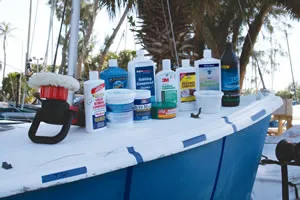
Meguiars No. 91 & Polarshine 35
New gelcoat is polished and waxed to a bright shine, but after a few years in the elements, it will begin to oxidize. An extensive test in the spring of 2014 (see PS April 2014 online) evaluated various rubbing compounds ability to remove oxidation and scratches and whether the products left swirl marks. Our test boat was a badly oxidized 1974 ODay Javelin daysailer whose once dark-blue hull had degraded into a chalky mess.
We focused on 11 coarse and medium-coarse products from top brands such as 3M, Shurhold, Dolphinite, and West Marine; some lesser-known makers such as Mirka and Hawkeye; and a few from car-maintenance retailers like Meguiars and Turtle Wax.
The compounds were applied to different sections of the Javelins hull using a Shurhold 3100 electric polisher and wool compounding pads. Testers evaluated the compounds viscosity, how well they went on the wool pad, and their ease of application. Ideally, a rubbing compound should allow five to 10 minutes of working time before it dries out. Testers found that several factors affected working time, including the amount of silicone, or petroleum distillates, in the formula, ambient weather, buffing machine speed, and how much compound was applied.
We had two favorites in this test. The first is a relative outlier in the U.S. market. Mirka, a Finnish company with an office in Ohio, offers Polarshine 35, a medium-coarse grit, silicone-free liquid compound that is water-based but does include some petroleum distillates. It clings to a hull surface well and goes on easily without drying out. Testers found that although the Mirka is not a finishing compound, its shine lasted for more than a month. It can be applied at varying, higher speeds, essentially acting as a coarse- and a fine-grit compound.
Our other favorite was from Meguiars, a U.S.-based company whose products are widely distributed in North America. Meguiars Power Cut No. 91 Compound (professional grade) is a fast-cut compound designed to remove sanding scratches and heavy oxidation without scouring the gelcoat finish. The coarse-grit, medium-thick liquid quickly removed the test boats heavy oxidation and light scratches. It did not splatter, create dust, or leave swirls, and it offered a very good shine that survived for more than a month after application. At $1.38 per ounce, the Meguiars No. 91 is at the high end of the test fields price range and tied the Polarshine 35 for our Best Choice. Both were named to this years top gear list.
IMGCAP(13)]
303 High-Tech Fabric Guard
Collectively, canvas products represent a substantial financial investment, so for the February 2014 report, we looked for the best way to get the most life out of canvas. We tested seven treatments formulated to add water-repellency to marine canvas: AquaTech Marine Water Repellent, Marykate Waterproofer (CRC Industries), 3M Outdoor Watershield, Gold Eagle 303 High-tech Fabric Guard, NikWax TX-Direct Spray-on, Star brite Waterproofing with PTFE, and Iosso Water Repellent.
We applied the test products to clean swatches of older, used Sunbrella that we left outdoors and treated every 30 days, according to manufacturer instructions, for up to four months. We checked the compatibility of our test products with clear vinyl windows and evaluated water repellency. All of the test products continued to prevent seepage for over 60 days, even though surface beading stopped by that time on some samples. To evaluate stain resistance, we examined areas frequented by fouling birds.
Our finalists (3M Outdoor Watershield, 303 High-Tech Fabric Guard, NikWax TX-Direct Spray-on, and Star brite Waterproofer with PTFE) were then applied to the Sunbrella aboard tester Drew Fryes PDQ 32 catamaran for real-world testing during a Virginia summer. We graded the treatments for coverage, water repellency, and stain resistance.
PSs Best Choice-and the 2014 Editors Choice-went to the 303 High Tech Fabric Guard, which is also recommended by Sunbrella. Testers preferred the bottles trigger action over aerosol for efficiency and ease of use; the trigger-spray products went on evenly and were easier to apply from the recommended distance, while the aerosols fine mist blew away in a light breeze. Testers also liked that the 303 has no silicone, which has been known to cause clear vinyl to fog. It is the most expensive product we tested, but it was a dependable performer.
Photos by Ralph Naranjo and Drew Frye

2)]
EisenShine
Clear-vinyl dodger windows are annoying tattle tales, announcing every bit of rough handling and neglect. In an effort to disguise some of this neglect, we tested two-step compounding and polishing products claiming to restore weathered vinyls clarity and to remove fine scratches and yellowing. The test field comprised one spray and 12 cream products from Star brite, Camco, Novus, EisenShine, Meguiars, and Sudbury.
Because we wanted to avoid newer vinyl that would not benefit (and might even be harmed by) compounding, we tested older dodgers. The samples varied in vinyl material quality and the extent of deterioration, but all the test samples were 40 mil thick and evenly weathered.
With each product pair, we compounded one vinyl section by hand to test each systems ability to remove haze, plasticizer bleed, and grime. A second sample was compounded with a rotary buffer to test the products ability to remove fine scratches and fogging. Testers then followed each brands compound with its matching protectant.
To quantify clarity improvement, testers counted the number of layers of restored product required to give the clarity equivalent of a single control panel. Testers also looked for products that removed fine scratches and passed water-beading tests.
EisenShine, developed for the companys mobile detailing business, is now available to the public for just $60. This sounds expensive, but it is sold with buffing accessories, which makes it difficult to make direct cost-comparisons.
For application by hand, the EisenShine Stripper compound easily removed grime with modest effort. It was aggressive enough to remove moderate scuffing and fine scratches without any unwanted side effects. When machine buffed, the difference between compounds was less dramatic, but EisenShine remained the top performer. The Clear Vinyl Protectant is also effective at restoring gloss and providing extended water beading. Because of this, our testers awarded the EisenShine system an Editors Choice pick.
